Few design choices lift a home’s welcome quicker than a living vignette right at the threshold. Front door plants soften brick, frame architecture, and invite butterflies while signaling the care that waits inside. Whether your entry bakes in full afternoon sun or nestles beneath a shaded portico, there is a container-friendly species ready to serve year-round structure, seasonal color, fragrance, or even edible rewards. Recent guides highlight how a balanced mix of evergreen “thrillers,” flower-packed “fillers,” and trailing “spillers” can dramatically raise curb appeal without complicated maintenance. Step across this green threshold to find twenty proven options—and the little coaching each one needs to keep your welcome mat blooming.
1. Boxwood Topiary – The Sculpted Front Door Plant
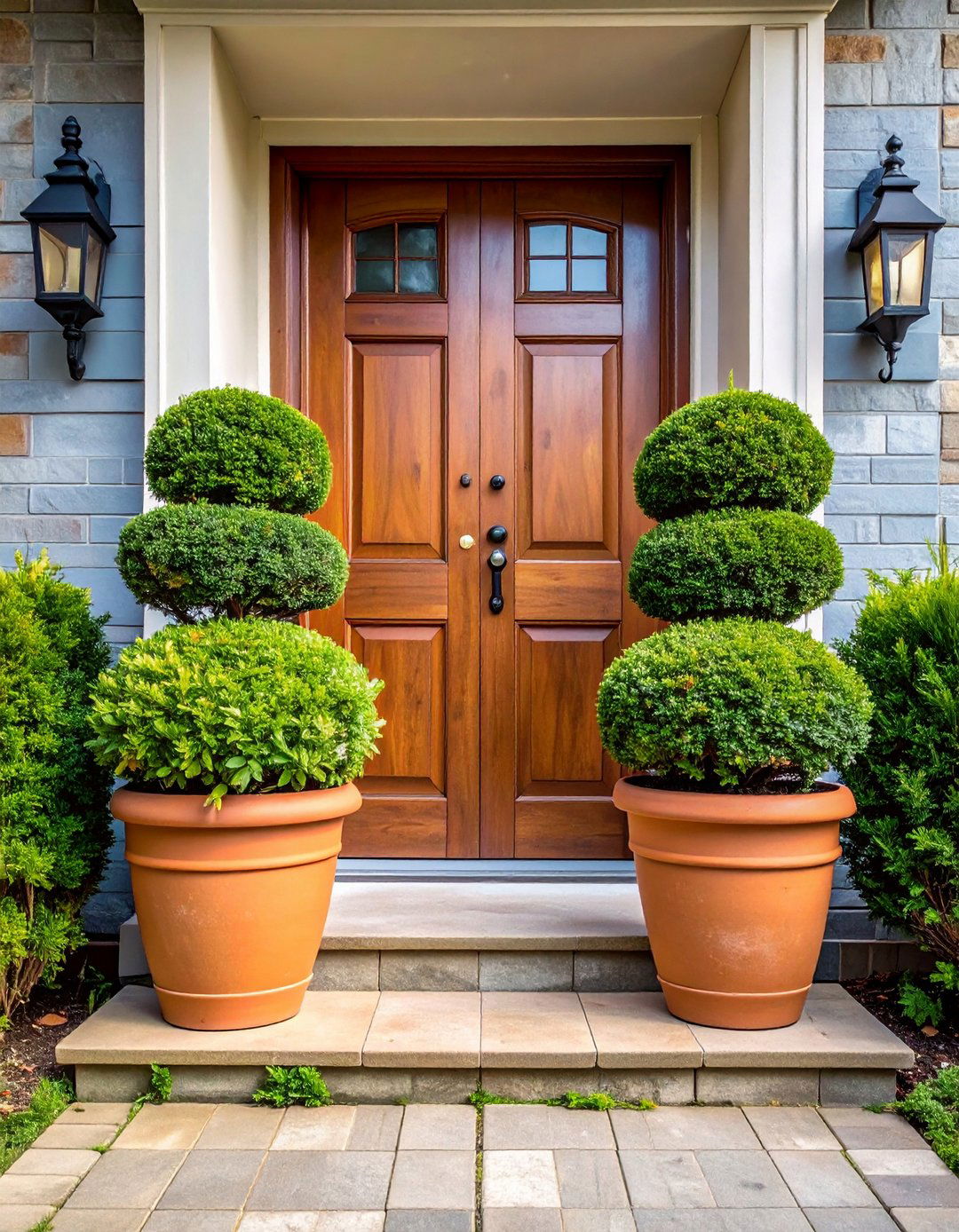
A single pair of sculpted boxwood topiary instantly signals order and elegance the moment guests step onto the path. As an evergreen front door plant, boxwood retains glossy foliage year-round, supplying reliable structure when annuals fade. Choose a compact cone, spiral, or ball form that reaches 3–5 ft and situate it in a frost-proof pot at least 18 in wide, allowing the rootball breathing space while preventing tipping in gusty weather. Keep the soil evenly moist and clip lightly every six weeks in the growing season to maintain shape without stressing new growth. Because boxwood tolerates partial shade, it performs on north-facing porches where showier bloomers struggle, ensuring four-season curb appeal.
2. Hydrangea Mopheads – Flower-Laden Front Door Plant
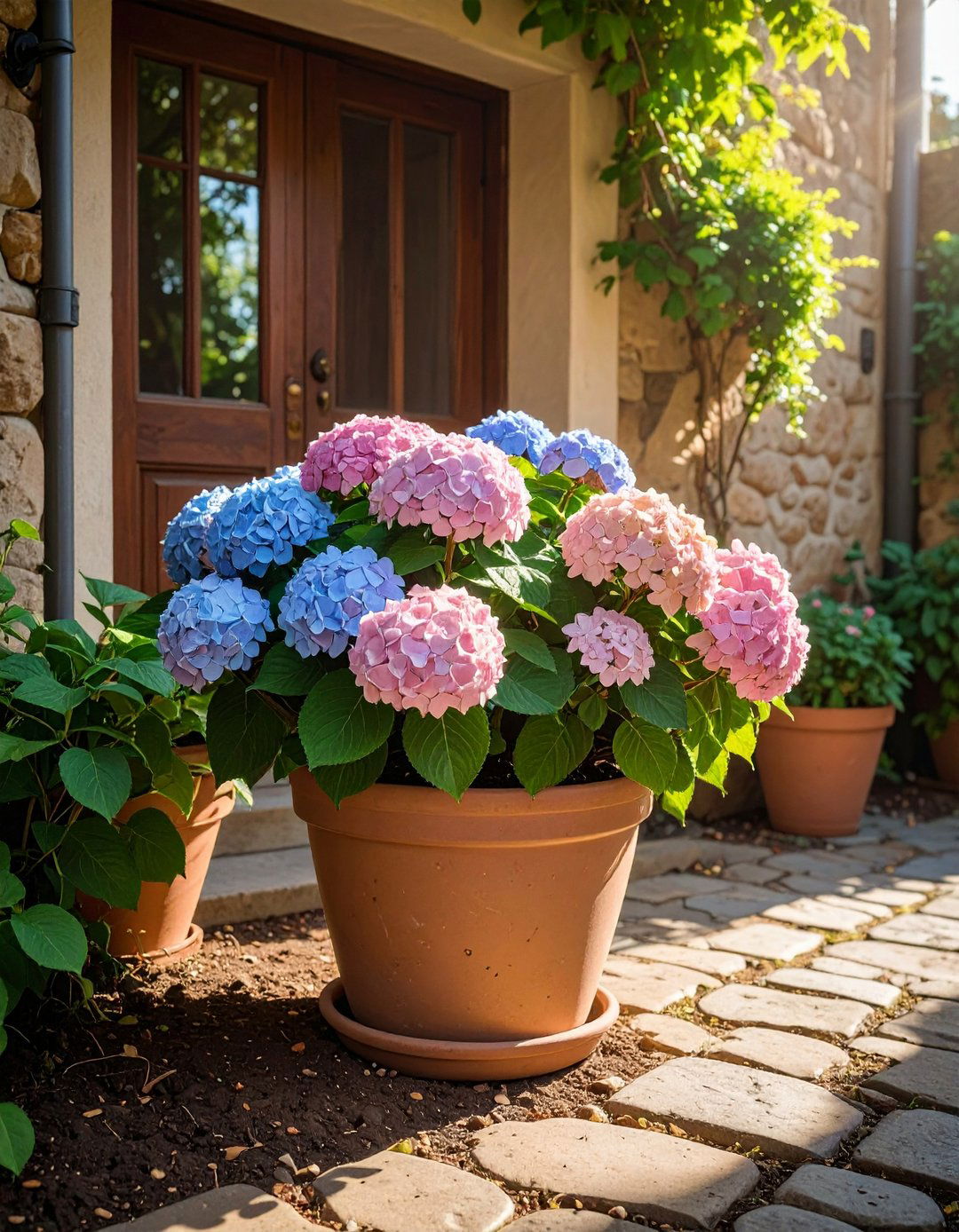
Unlike many shrubs, mophead hydrangeas happily bloom in roomy containers, making them a show-stopping front door plant that shifts from lime-green buds to pastel pompoms through the season. Select a pot 16–24 inches wide with moisture-retentive soil; the generous diameter keeps roots cool and supports stems weighed down by plate-sized flowers. Morning sun and afternoon shade prevent both leaf scorch and color fade, while a monthly drink of balanced fertilizer sustains repeat flushes. Dead-heading spent blooms back to a pair of healthy leaves maintains tidiness without removing next year’s buds. On cold nights, wheel the container against the house wall for insulation, and your hydrangea will reward the entry with reliable clouds of color for years.
3. Compact Lavender – Aromatic Front Door Plant
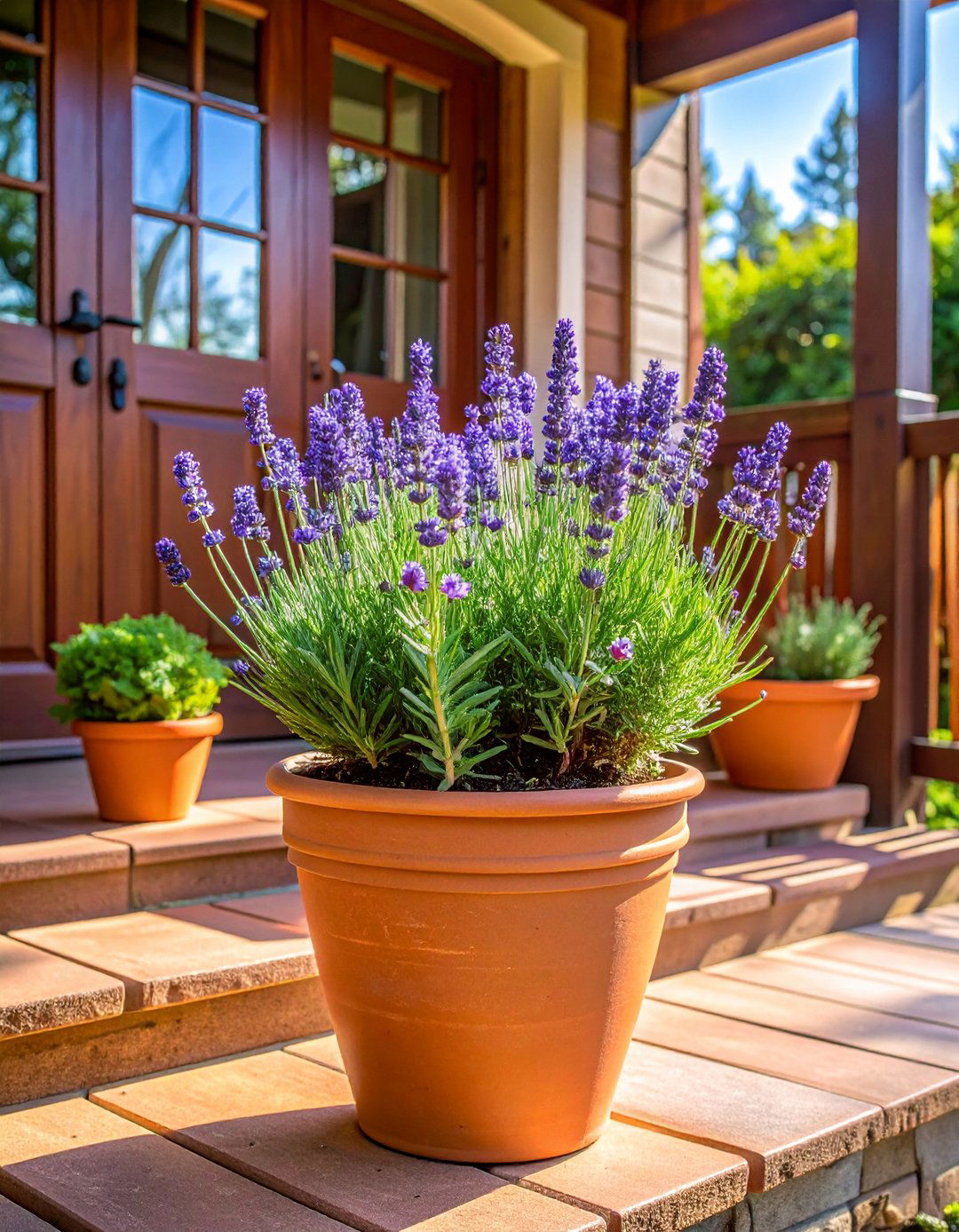
Consider the scent-trail guests follow when a compact English lavender crowns your threshold: airy spikes hum with bees, and the herbal perfume whispers relaxation before the door even opens. This drought-tough front door plant only asks for a clay pot at least 12 inches across, gritty fast-draining mix, and six hours of direct sun. Trim spent wands by one-third after the first flush to prompt a second bloom, and avoid over-watering—roots resent wet feet more than brief dryness. As southern summers peak, the silver foliage reflects heat, keeping soil cooler. Snip a few fresh stems whenever you need culinary flavor or homemade sachets, and the plant quickly repays the haircut with renewed, tidy growth.
4. Dwarf Alberta Spruce – Conifer Front Door Plant

Hence, a neat dwarf Alberta spruce gives front doors a miniature Christmas-tree silhouette that stands sentinel every month of the year. The slow-growing conifer stays under 6 feet in a container, making it an ideal evergreen front door plant for tight stoops. Provide a deep, well-drained pot and orient the tree where it will receive at least half a day of sun to keep needles dense. Water thoroughly, then allow the top inch of mix to dry before the next soak to discourage root rot. An annual spring dose of balanced, slow-release fertilizer is enough nutrition; excessive feeding spurs lanky growth. Rotate the pot quarterly for uniform shape, and sweep fallen needles into compost.
5. Mini Hostas – Shade-Tolerant Front Door Plant
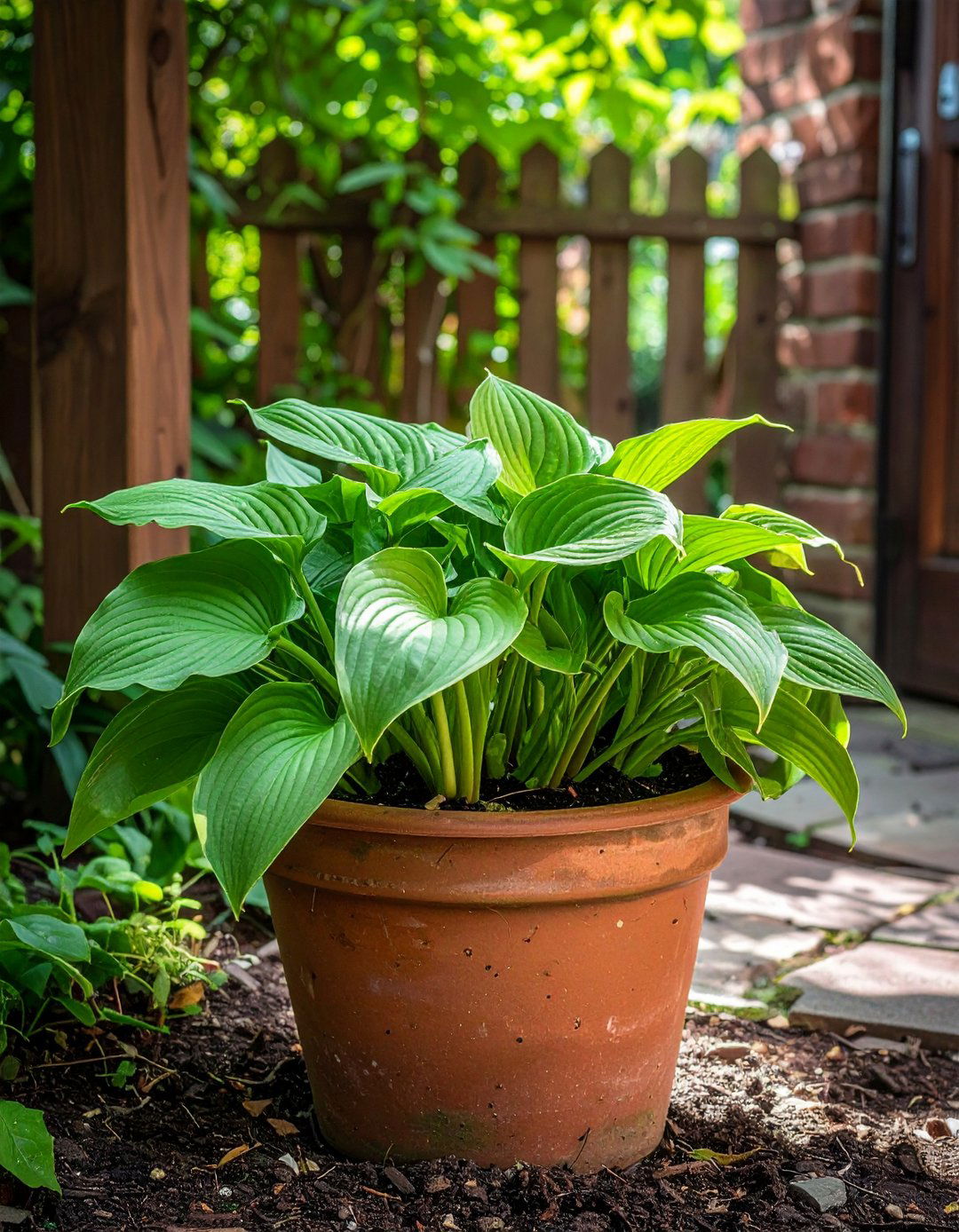
Surprisingly, hostas—often thought of as bedding foliage—perform beautifully in pots when placed at a shady entry, giving homeowners a lush, fountain-like front door plant without flowers to dead-head. Miniature cultivars such as ‘Blue Mouse Ears’ fill a 12-inch vessel quickly, their thick leaves shrugging off occasional drought far better than larger cousins. Use a rich, compost-infused medium and tuck a layer of mulch over the crown to conserve moisture. Divide plants every three years as the root mass tightens, repotting divisions into matching containers to flank both sides of the door. A sprinkle of organic slug bait keeps foliage pristine, and the broad leaves offer an elegant textural foil to neighboring bloomers.
6. Boston Fern – Lush Hanging Front Door Plant
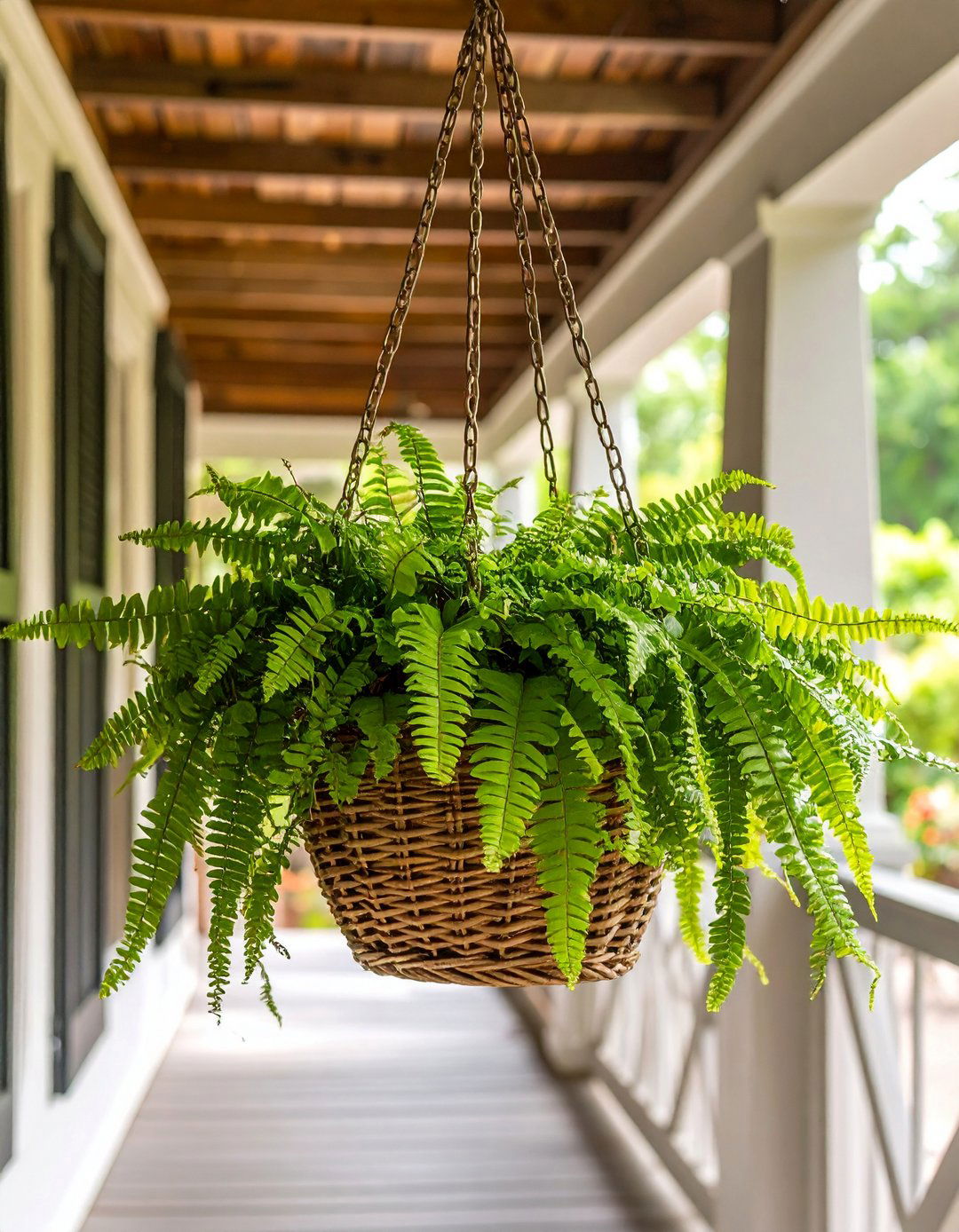
With arching fronds that brush ankles like living lace, a hanging Boston fern brings instant softness to covered entries and functions as a forgiving front door plant for deep shade. Keep the 10-inch basket moist—never soggy—by dunking it in a bucket of water each week during hot weather; the root ball wicks up just enough without waterlogging. Frond tips brown if humidity drops, so mist lightly or cluster multiple plants to raise ambient moisture. Monthly feeding with a diluted balanced fertilizer supports lush green growth. When winter chills threaten, the same basket moves indoors to a bright bathroom where steam from showers mimics its native understory habitat, ensuring year-round feathery drama.
7. Dwarf Japanese Maple – Elegant Front Door Plant
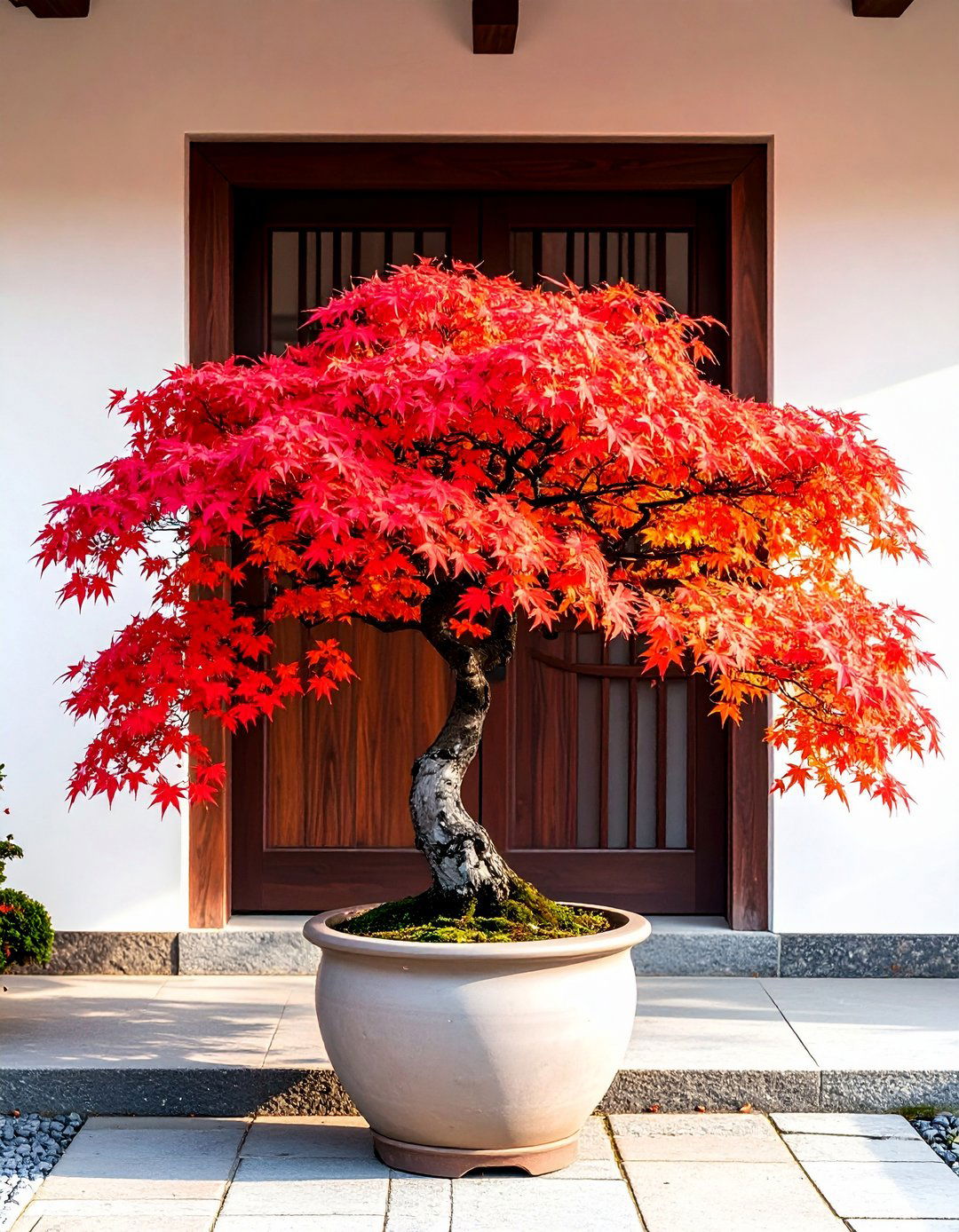
A dwarf Japanese maple turns the entrance into a seasonal art piece—filigreed leaves unfurl in spring, blaze crimson in autumn, and showcase sculptural branches in winter. Such year-round interest makes it a refined front door plant for design lovers. Choose a cultivar that stays under 10 feet and nest it in a glazed pot at least 20 inches wide to buffer roots from heat. Position where it receives morning sun and afternoon shade to prevent leaf scorch, and water deeply but infrequently, allowing the mix to dry slightly between drenches. A top-dressing of shredded bark evens soil moisture and protects the shallow roots. Prune only dead or crossing twigs to maintain the tree’s natural architecture.
8. Rosemary Cone – Culinary Front Door Plant
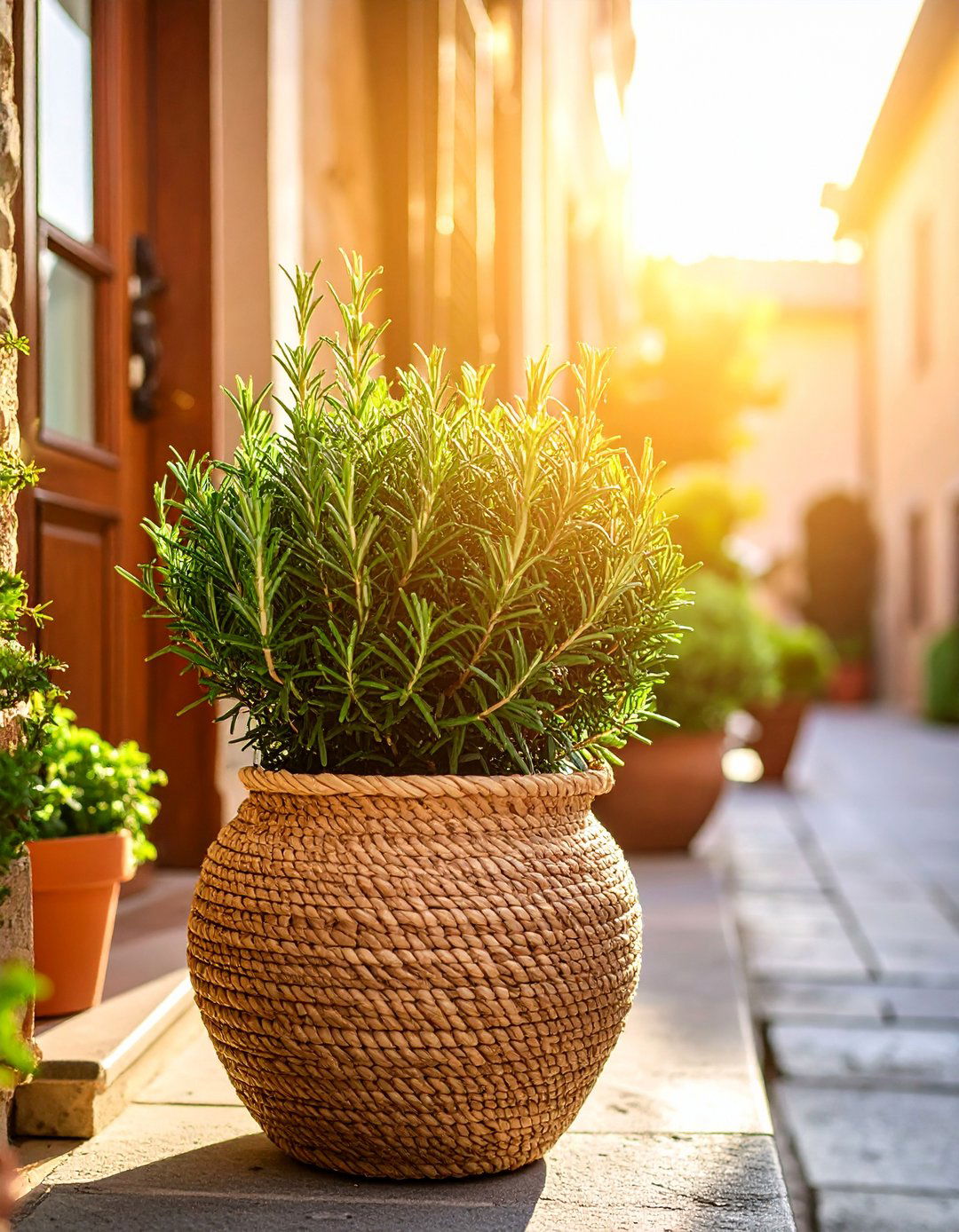
Few plants serve both kitchen and curb appeal as seamlessly as a rosemary cone trimmed into fragrant geometry beside the threshold. This drought-resistant herb thrives as a sun-loving front door plant while offering an endless supply of sprigs for roasts. Provide a terracotta pot to keep roots aerated and water only when the top inch dries; overwatering, not drought, is the usual culprit in failure. Pinch growing tips weekly to encourage bushiness and release oil-rich scent each time you brush past. During wet monsoon spells, slide the pot under the eaves to keep foliage dry and prevent fungal woes. A light application of organic, low-nitrogen fertilizer in spring sustains flavorful, compact growth.
9. Gardenia – Perfumed Evergreen Front Door Plant

Nothing announces hospitality like the sweet perfume drifting from a potted gardenia stationed beside the bell. As a glossy-leaved, evergreen front door plant it supplies scent, texture, and off-season interest in mild climates. Select the hardier cultivars bred for container culture, move them into an acidic, peat-based mix, and maintain consistent moisture without waterlogging. Full morning sun followed by high-bright shade encourages bud set while sparing flowers from afternoon scorch. Feed monthly with an acid-loving fertilizer during active growth to dodge yellowing leaves. In zones where winter temperatures dip below 10 °C, wheel the pot into a bright foyer until spring; cooler indoor nights actually prolong the decadent bloom show.
10. Camellia – Winter-Blooming Front Door Plant
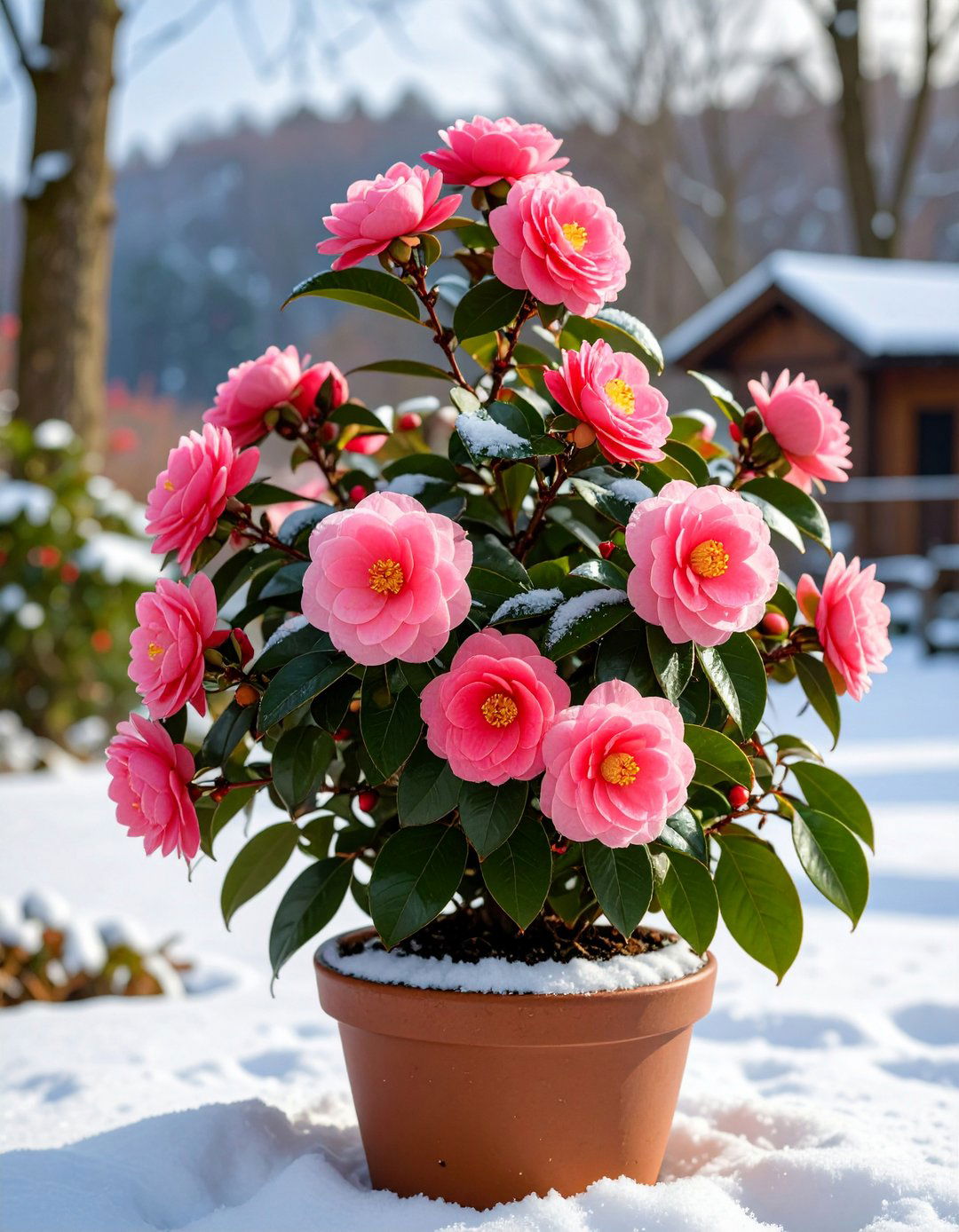
By late winter, when most landscapes lie bare, a potted camellia unfurls rose-like flowers at eye level, earning its place as a luxurious front door plant for chilly seasons. Position the container where it catches early light and dappled afternoon shade to prevent petal scorch. Camellias crave consistent moisture but detest saturated roots, so pick a pot with generous drainage and layer pine-bark mulch atop the soil. Keep pH slightly acidic with occasional applications of sulfur or specialized fertilizer. Remove spent blooms promptly to reduce disease risk and redirect energy into next year’s buds. Over time, prune just after flowering, cutting back no more than one-third to keep the shrub compact and doorway-friendly.
11. Blue Fescue – Textural Front Door Plant
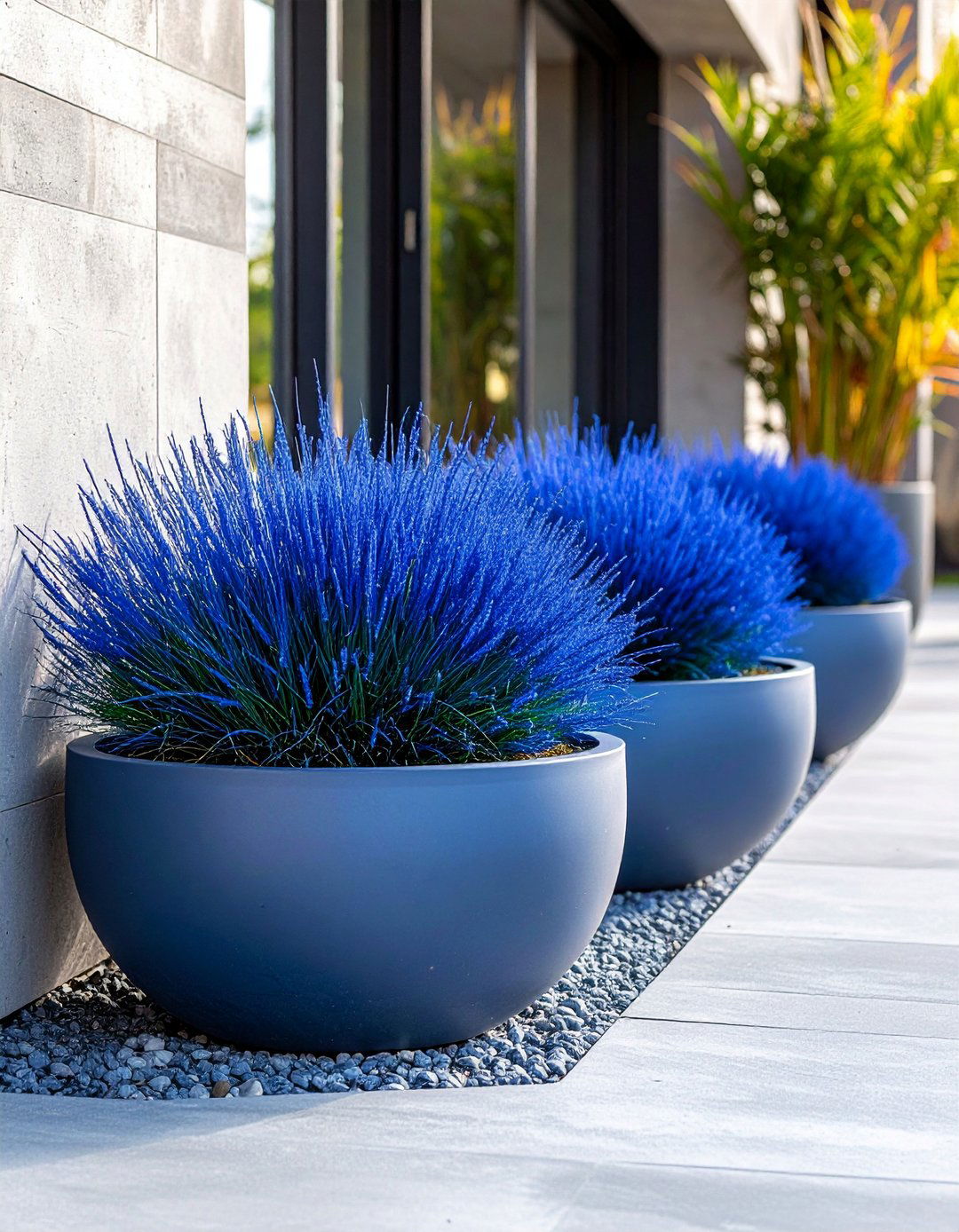
Owing to its steely hue and tidy mound form, blue fescue is an understated yet modern front door plant that accentuates concrete, steel, or mid-century textures. Plant several in low, wide bowls for a rhythmic border or cluster one pot among larger shrubs as a textural highlight. This ornamental grass loves full sun and quickly suffers if overwatered, so choose a gritty, fast-draining mix and water sparingly once established. Trim flower stalks back after they fade to keep the clump neat, and divide every four years to rejuvenate color. Because blue fescue is pest- and deer-resistant, it forms a maintenance-light welcome mat that still feels fresh through winter.
12. Jade Plant – Lucky Front Door Plant

According to traditional Feng Shui, a jade plant near the entrance invites prosperity, but even skeptics value its chunky silhouette and low-maintenance instincts as a bullet-proof front door plant. A free-draining cactus mix in a ceramic pot prevents the fleshy stems from rotting during summer monsoons. Let soil dry completely between soakings—wrinkled leaves are your cue to water. Bright, indirect light deepens leaf color and can even encourage clusters of starry white blooms in winter. Remove leggy branches by cutting above a node; the trimmed section readily roots into a second welcome gift. Bring plants indoors when temperatures approach 5 °C, and they’ll continue guarding your financial and horticultural fortunes.
13. Snake Plant – Air-Purifying Front Door Plant
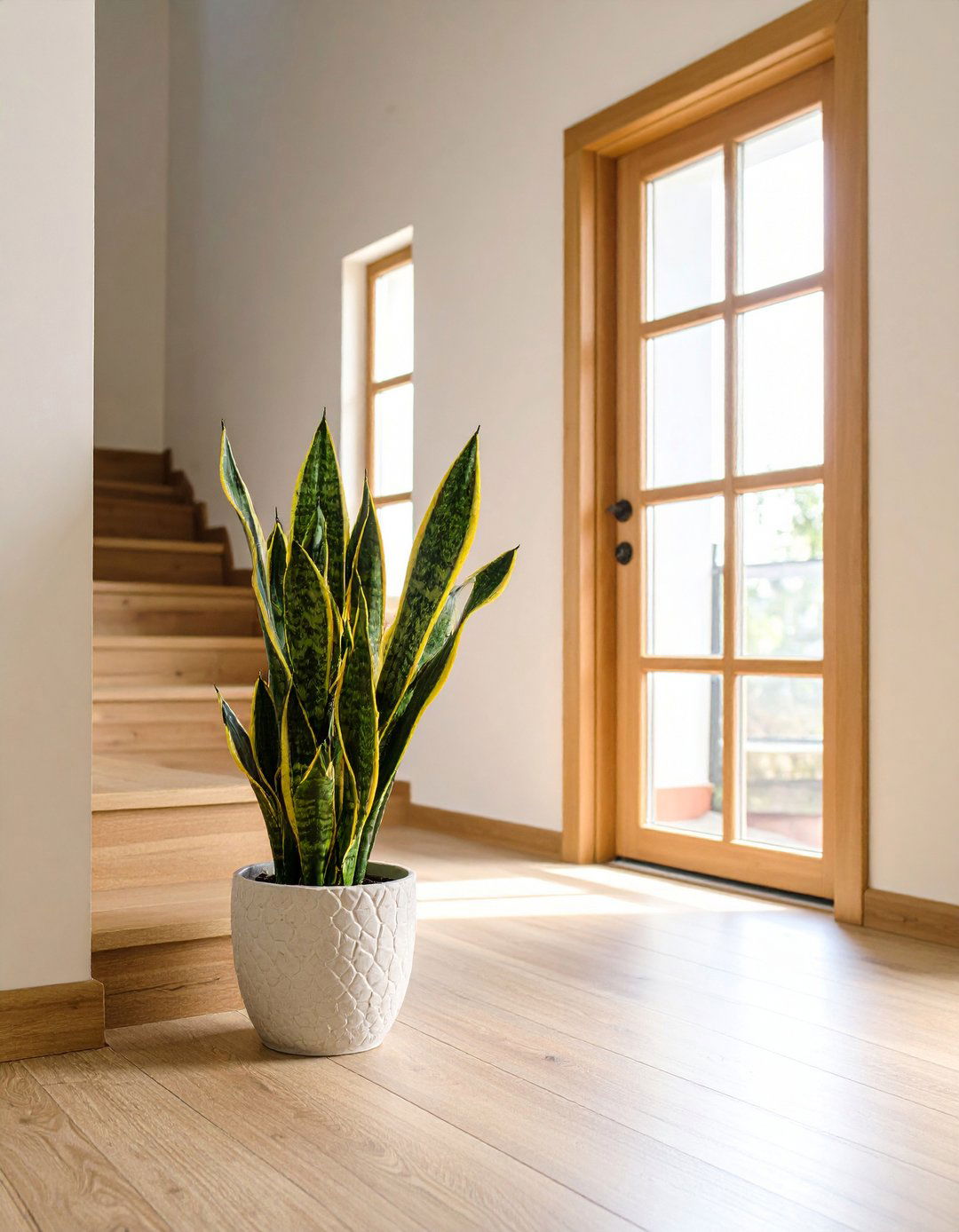
Certainly one of the toughest living sculptures you can choose, a snake plant delivers upright, variegated swords that read like modern art beside the doormat. As an air-purifying front door plant, it filters pollutants yet forgives weeks of neglect. Position it in bright, filtered light to maximize leaf patterning, but know it tolerates deep shade better than many houseplants. Use a sandy soil blend and water only when the top two inches are bone-dry; soggy roots invite rot. Remove damaged leaves at the base with clean shears, and wipe foliage monthly to keep photosynthesis efficient. Pet owners should place the pot beyond nibbling distance, as the plant’s saponins can upset furry stomachs.
14. Rubber Plant – Dramatic Foliage Front Door Plant
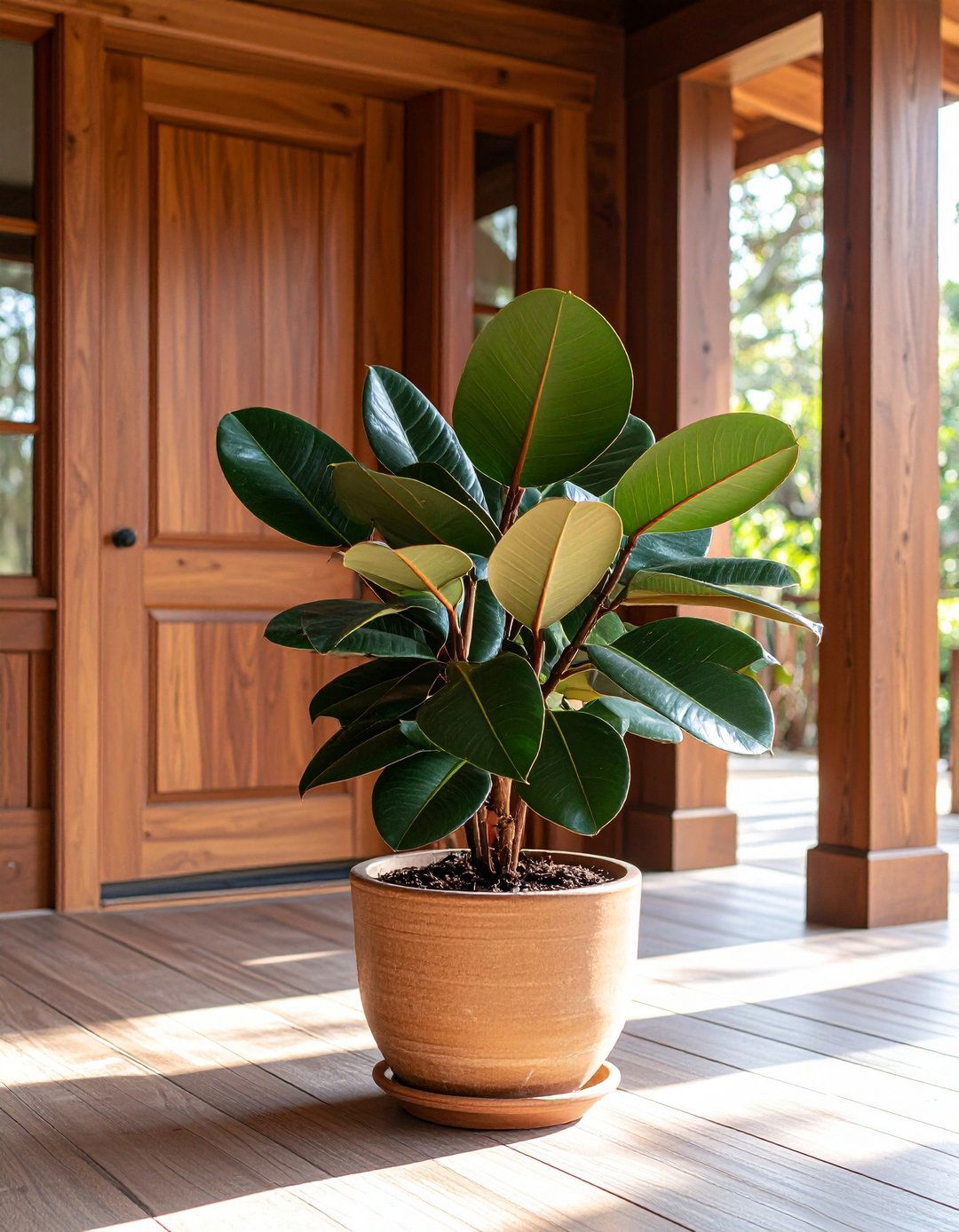
With glossy, dinner-plate leaves in burgundy or variegated cream, a rubber plant makes a bold, architectural front door plant for covered porches that receive bright, indirect light. Choose a container just a third larger than the root ball; oversized pots stay wet too long. Allow the top inch of mix to dry, then water deeply until liquid exits the drainage holes. Feeding twice a year with a balanced indoor fertilizer maintains sheen without causing leggy growth. If height begins to overwhelm the doorway, notch the stem and cut above a node to stimulate branching. Wipe leaves with a damp cloth to deter dust and amplify that signature showroom gloss.
15. Tropical Hibiscus – Showy Front Door Plant
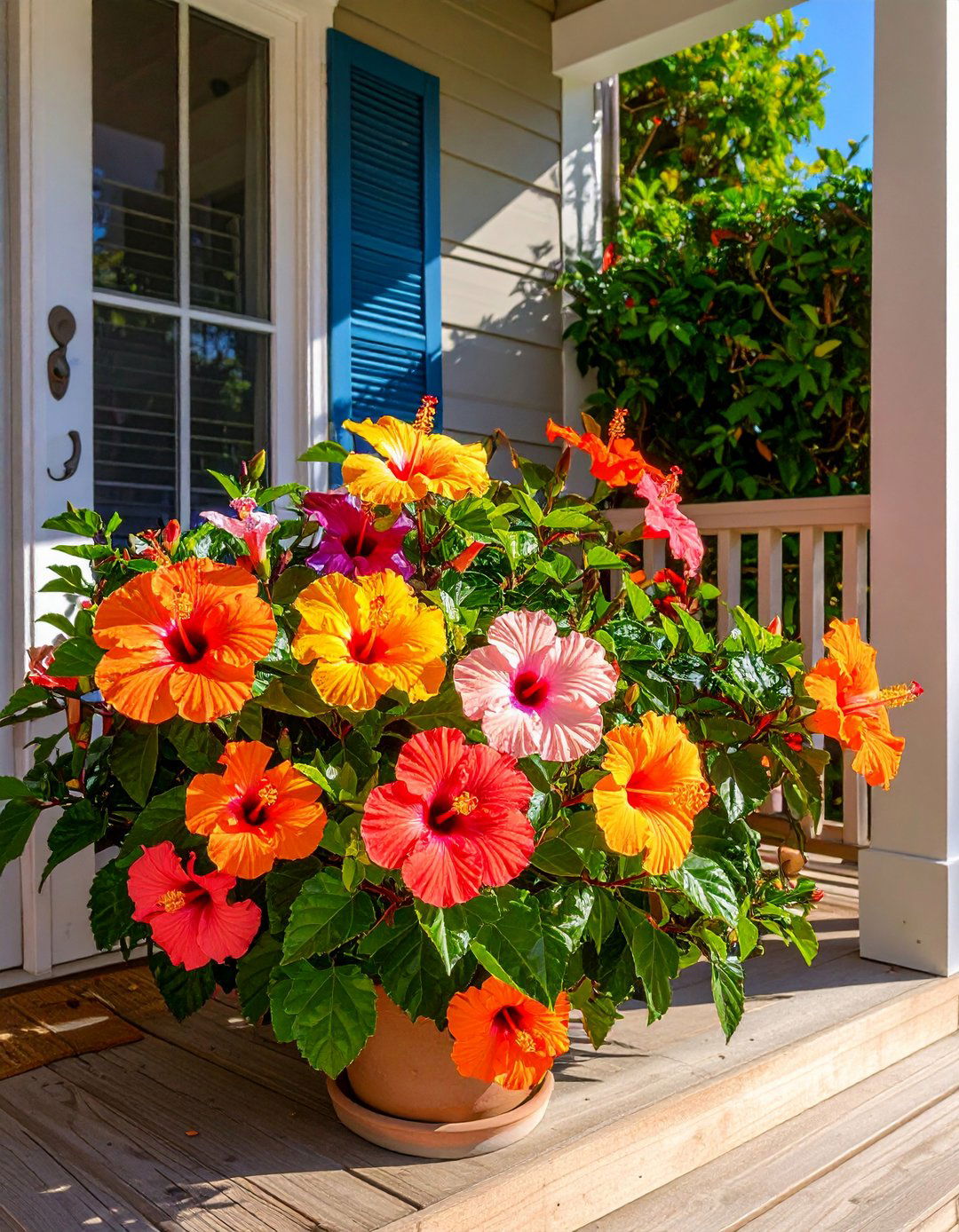
Looking for a dash of tropical theater? A containerized hibiscus erupts with plate-sized blooms in sunset shades, transforming the stoop into vacation mode and acting as a flamboyant front door plant all summer. Place the pot where it enjoys six hours of sun but is shielded from drying afternoon winds, and keep soil consistently moist yet never waterlogged. Bi-weekly applications of high-potassium fertilizer fuel the nonstop flower show. Prune lightly after each flush to shape the canopy and encourage more buds. When nighttime temperatures dip below 10 °C, relocate indoors to a bright window, reducing watering until spring to let the plant rest before next year’s encore.
16. Mandevilla – Climbing Floral Front Door Plant
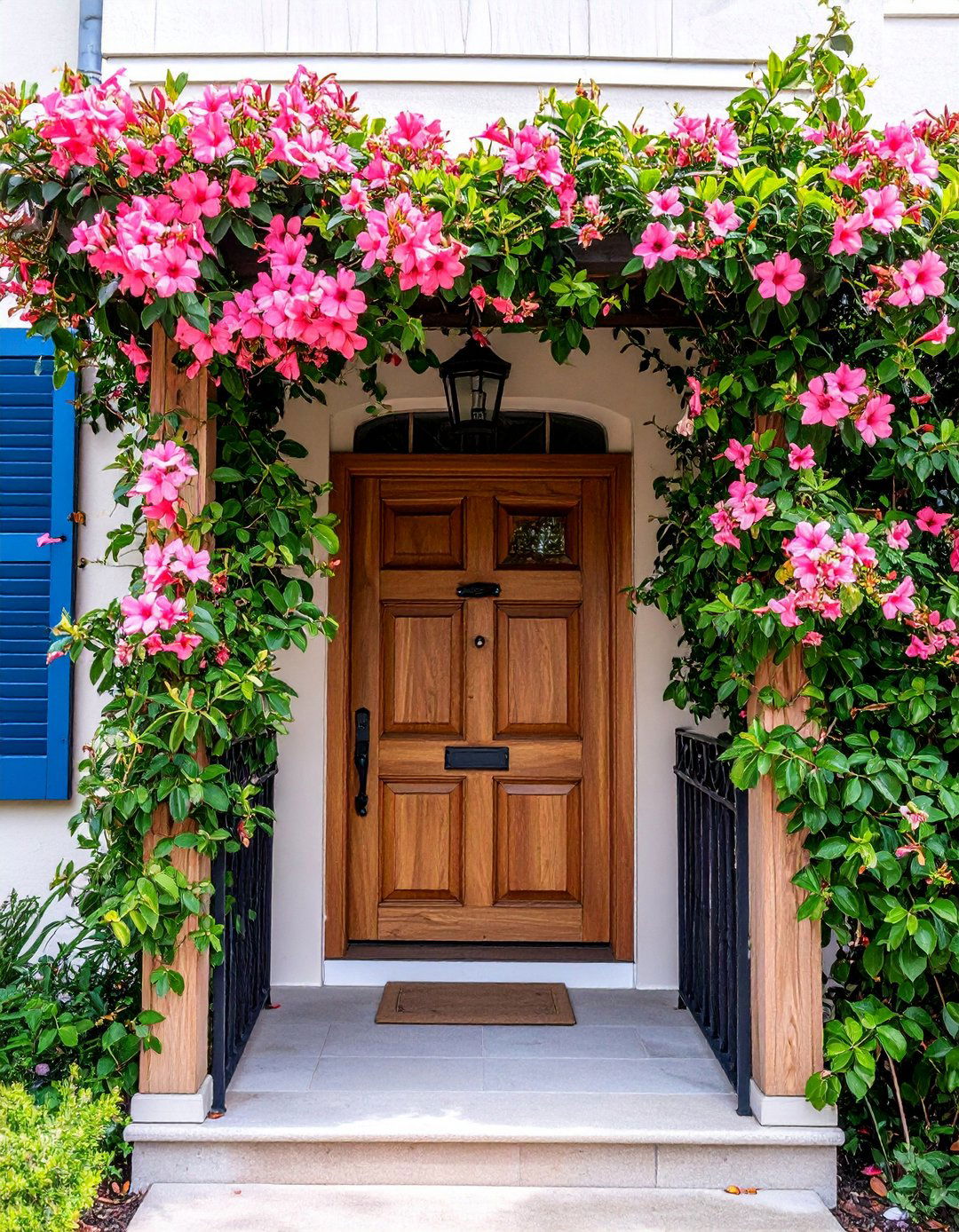
Another vine worth the trellis treatment is mandevilla, which wraps porch columns in glossy leaves and trumpet flowers, turning the entry into a living archway while behaving as a vertical front door plant. Offer sturdy support at planting time, because the twining stems set quickly. A loamy, well-drained mix and full sun foster the heaviest bloom set; water when the top inch feels dry, but avoid prolonged sogginess. Pinch growing tips early to induce side shoots and create denser coverage. Monthly feeding with a blooming fertilizer keeps petals coming until frost. Overwinter the root ball indoors in a cool, bright room; cut vines to 30 cm and growth will rebound vigorously in spring.
17. Calamondin Citrus – Edible Front Door Plant
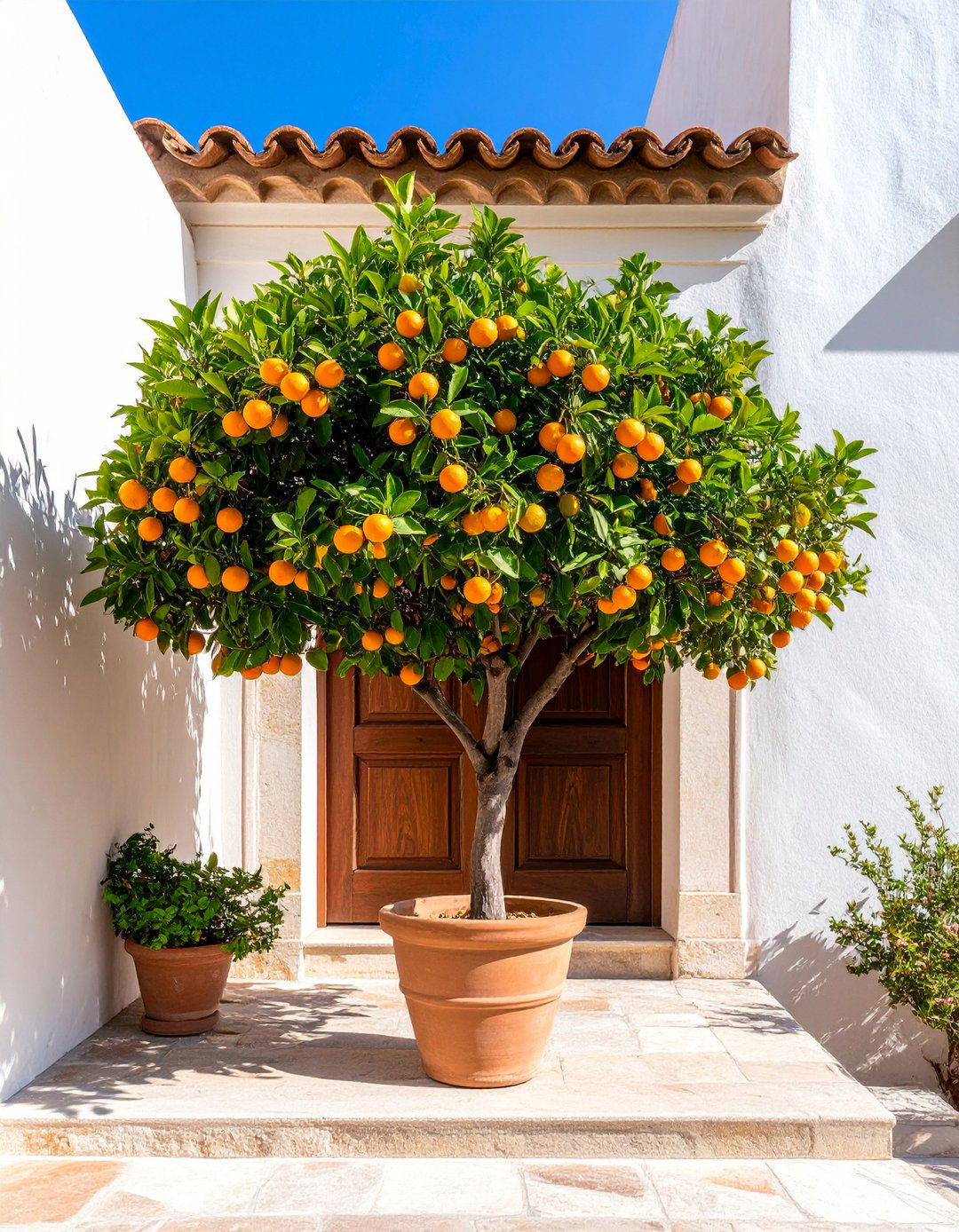
Few sights feel more Mediterranean than a potted calamondin dripping with miniature orange globes at the doorstep, offering scent, color, and edible zest from a single front door plant. Choose a dwarf grafted tree and set it in a terracotta pot 8–12 inches wider than its nursery container to accommodate the woody root system. Provide eight hours of direct light, supplementing with a grow light if your porch sits in shade. Water when the top inch dries and feed twice yearly with a citrus-specific fertilizer. Wheel the pot indoors once temperatures drop below 4 °C, placing it away from radiators to prevent leaf drop, and you’ll harvest tangy fruit almost year-round.
18. Begonias – Color-Packed Front Door Plant
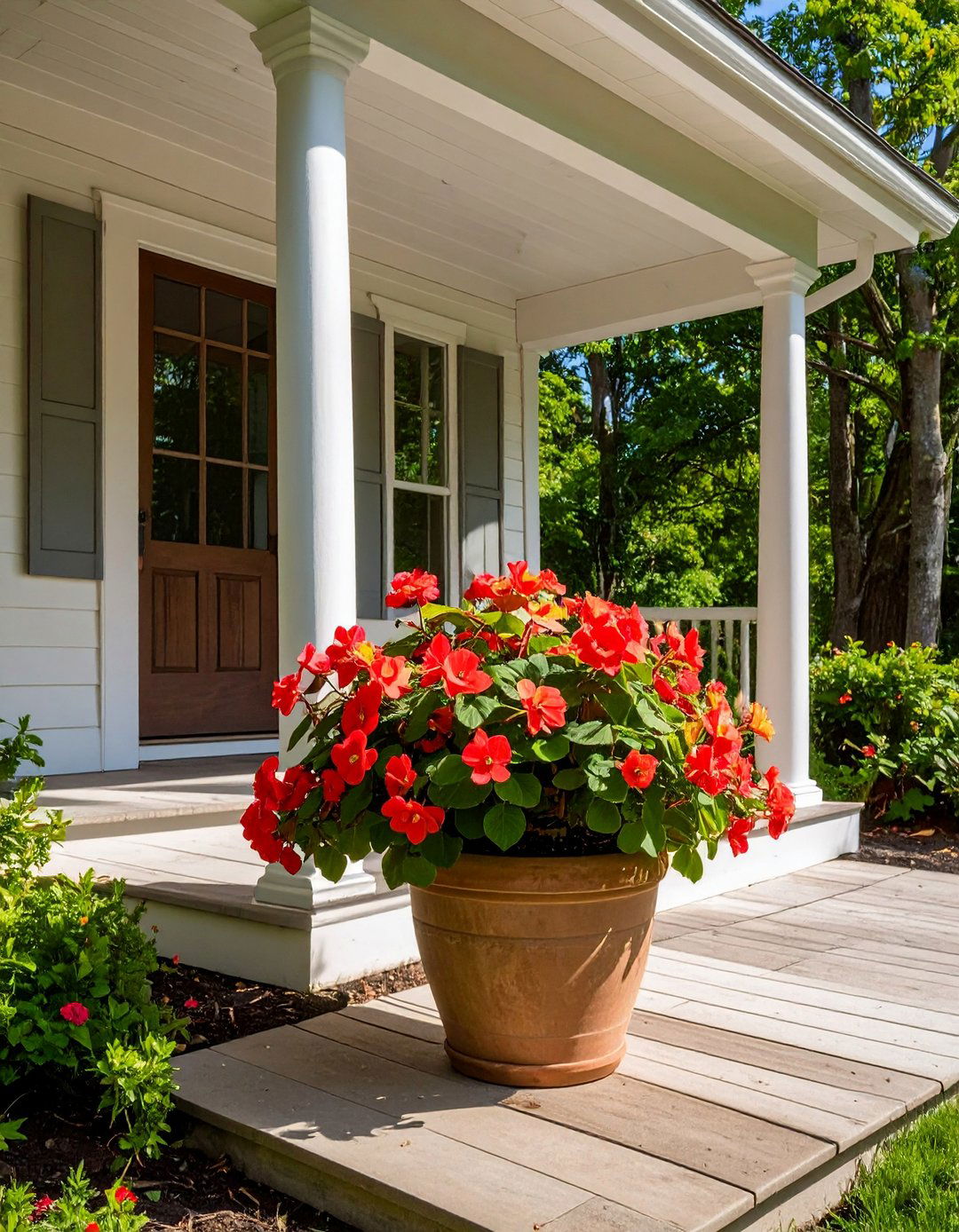
Another shade-scene stealer, begonias supply months of saturated color and glossy foliage from a relatively small footprint, making them a fiesta-ready front door plant for dim entries. Opt for non-stop or dragon-wing varieties that bloom continuously if dead-headed weekly. Plant three rooted cuttings into a 14-inch pot of rich, moisture-holding compost and water whenever the top half-inch feels dry. Avoid splashing foliage to reduce powdery mildew risk. Monthly feeding with a bloom booster keeps flowers abundant until the first frost. If your winters stay mild, cut the stems back to 2 inches and overwinter the tubers dry; otherwise, bring the entire pot inside a cool laundry room until spring.
19. Coleus – Kaleidoscopic Front Door Plant
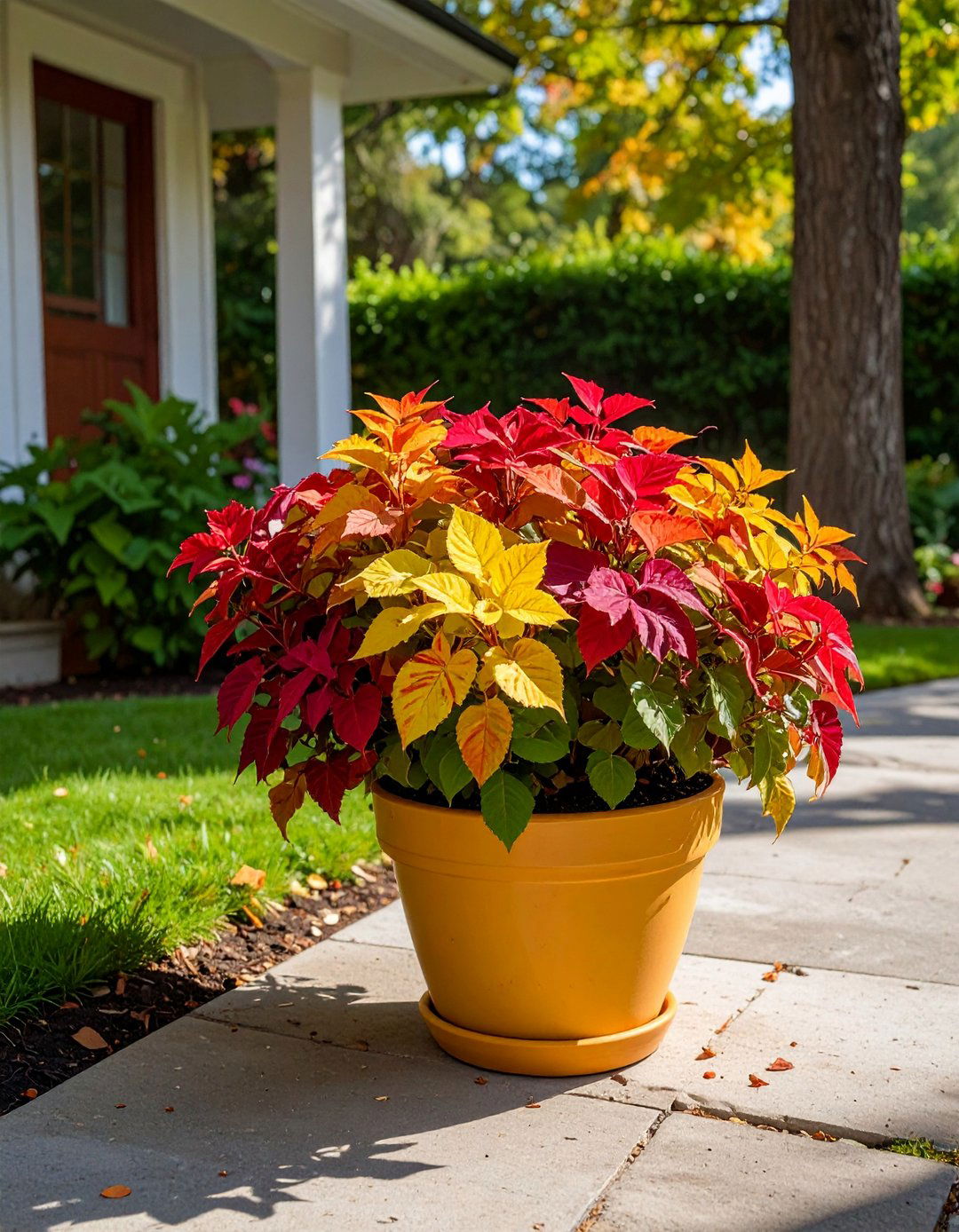
Despite lacking big blossoms, coleus earns rave reviews for its kaleidoscopic leaves, which turn a shady threshold into a living stained-glass window and prove this foliage favorite is an unforgettable front door plant. Select sun-rated cultivars if your porch receives strong light; otherwise, classic shade types shine under eaves. Pinch the tip above every second node to prevent flowers and keep color concentrated in the foliage. A lightweight potting mix enriched with compost encourages quick rooting, while regular, moderate watering prevents leaf scorch. Because coleus is frost-tender, take six-inch cuttings in late summer, root them in water indoors, and you’ll have fresh plants ready to greet spring.
20. Reblooming Azalea – Multi-Season Front Door Plant

To wrap things up, a reblooming azalea in a stylish ceramic pot ensures spring’s celebratory colors linger through summer and even fall, granting an enduring floral front door plant for partial shade. Use an acidic, bark-heavy medium and water whenever the top inch dries; containers dry faster than garden soil. After each bloom cycle, dead-head lightly and top-dress with slow-release fertilizer formulated for acid-loving shrubs to stimulate the next wave. Protect the root ball from winter freezes by wrapping the pot in burlap or shifting it to a sheltered wall, and your azalea will continue staging encore performances that guests and pollinators applaud.
Conclusion:
Welcoming greenery is not a one-size-fits-all decision; the twenty front door plants above prove you can match any exposure, style, or maintenance appetite with a living accent that elevates the entire façade. Evergreen anchors such as boxwood and spruce provide year-round bones, while season-stretching bloomers like camellia, hydrangea, and reblooming azalea layer on color exactly when other displays wane. Fragrant allies—lavender, rosemary, gardenia—reward every pass of the door, and edible gems like calamondin blur the line between landscape and pantry. Choose one hero or compose a trio following the thriller-filler-spiller rule, and your threshold will greet neighbors, pollinators, and—most importantly—you with daily vitality and style.


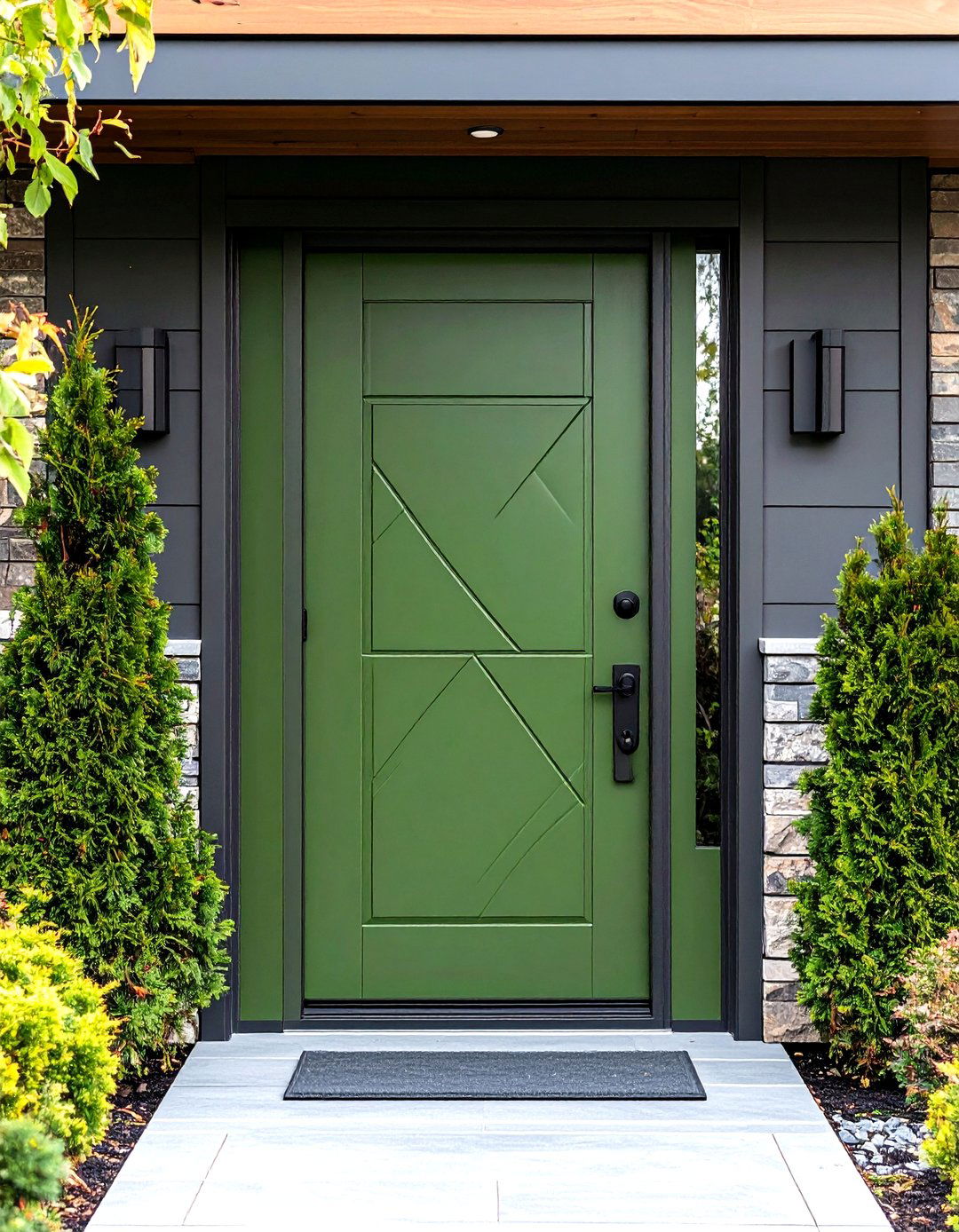

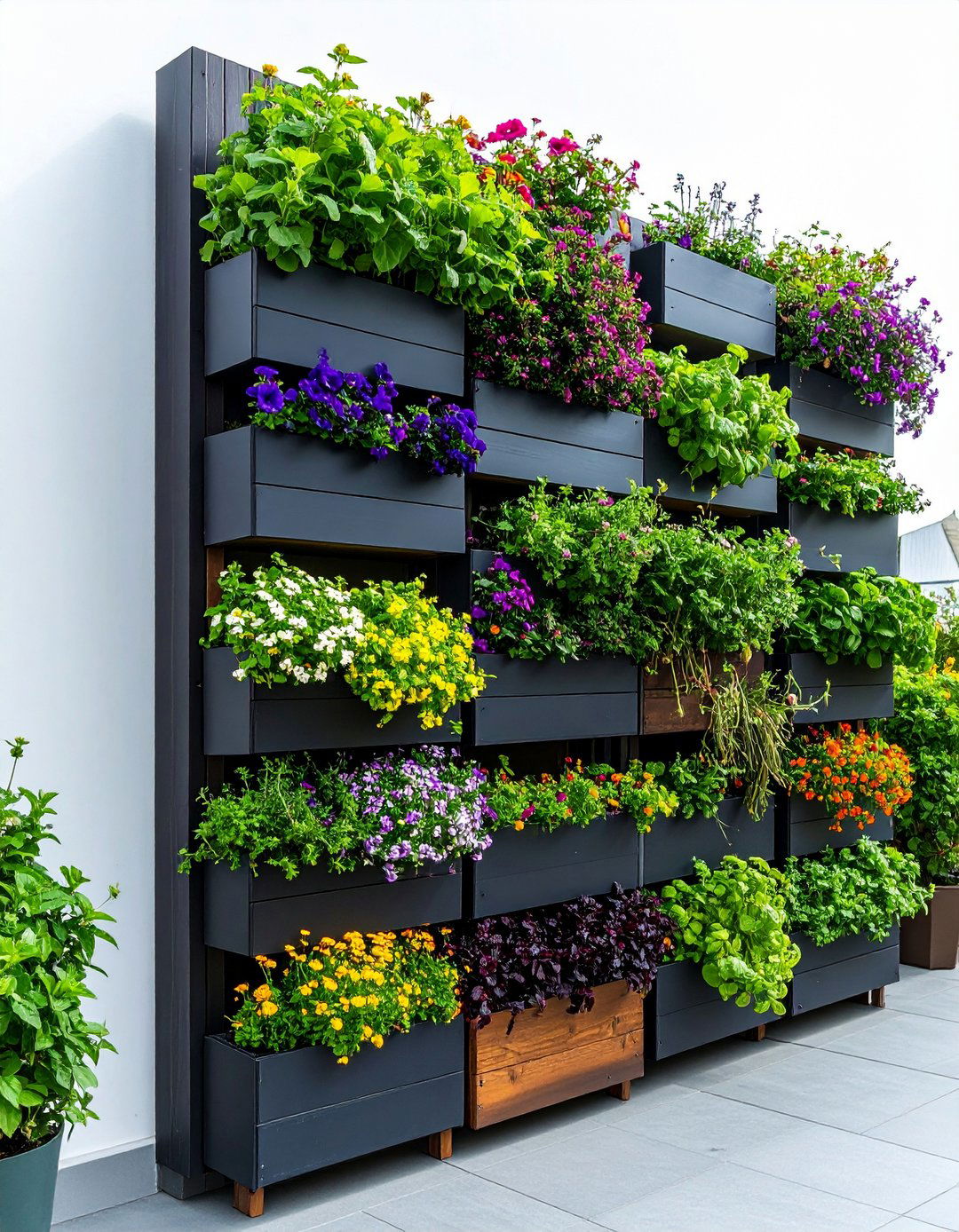





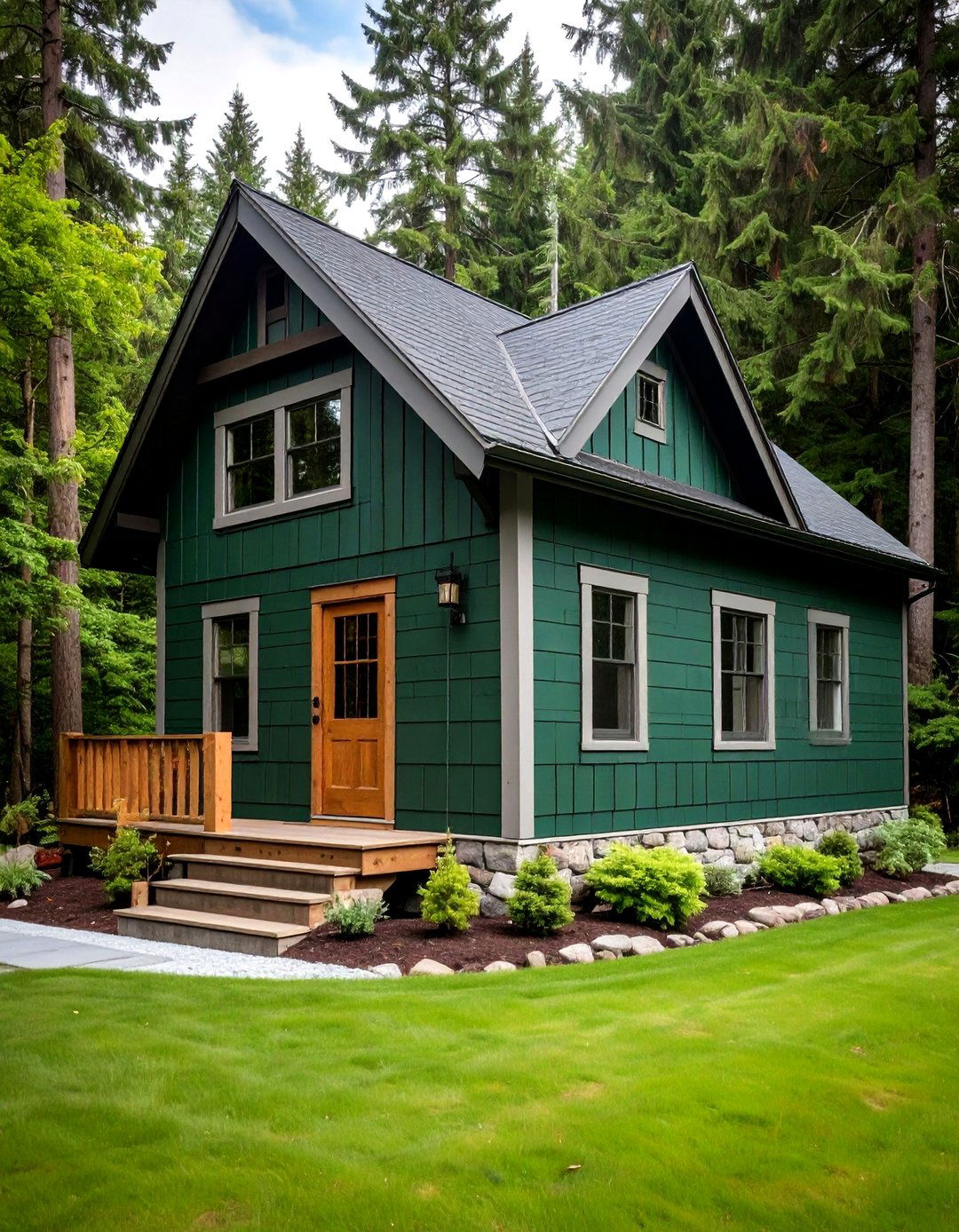
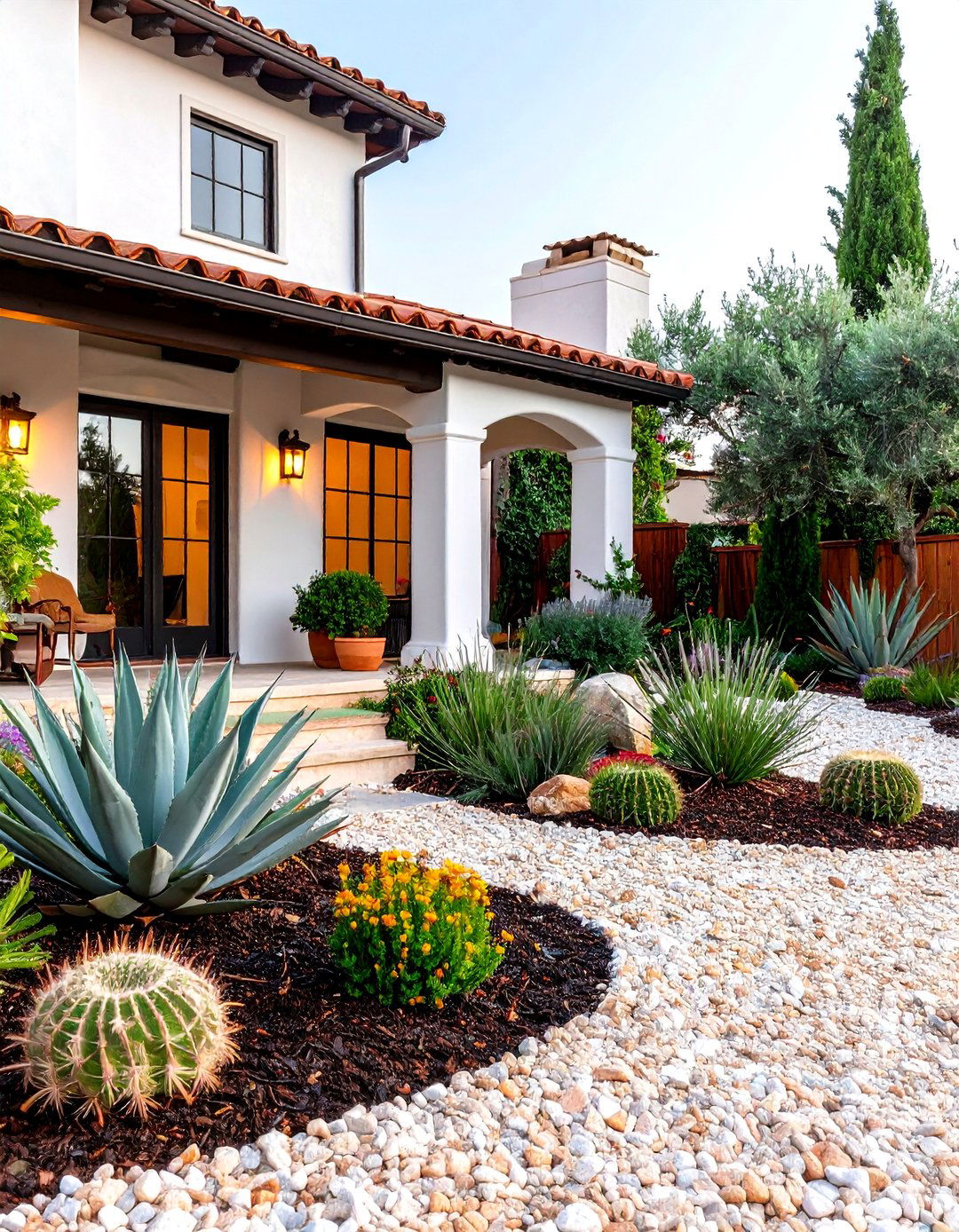

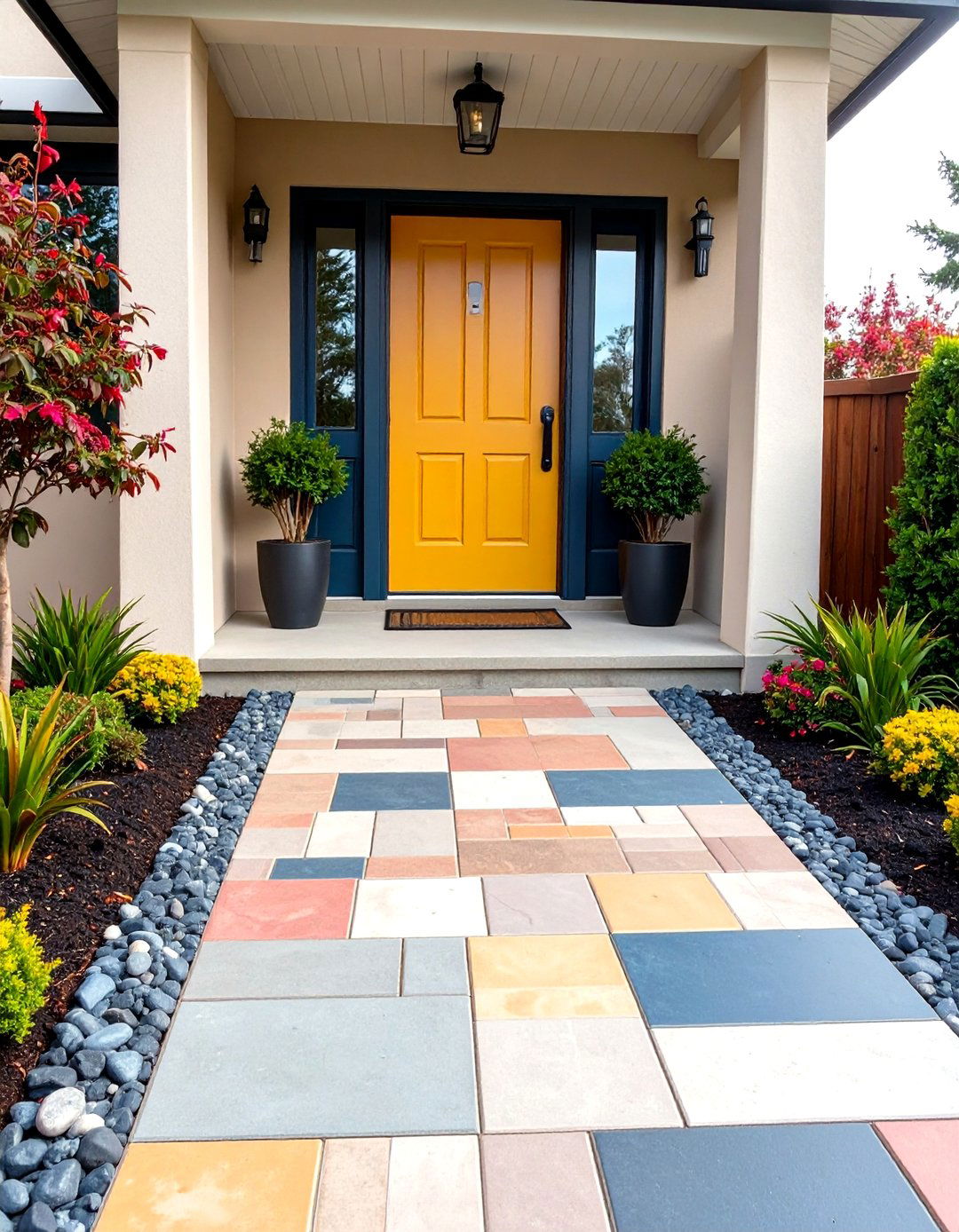
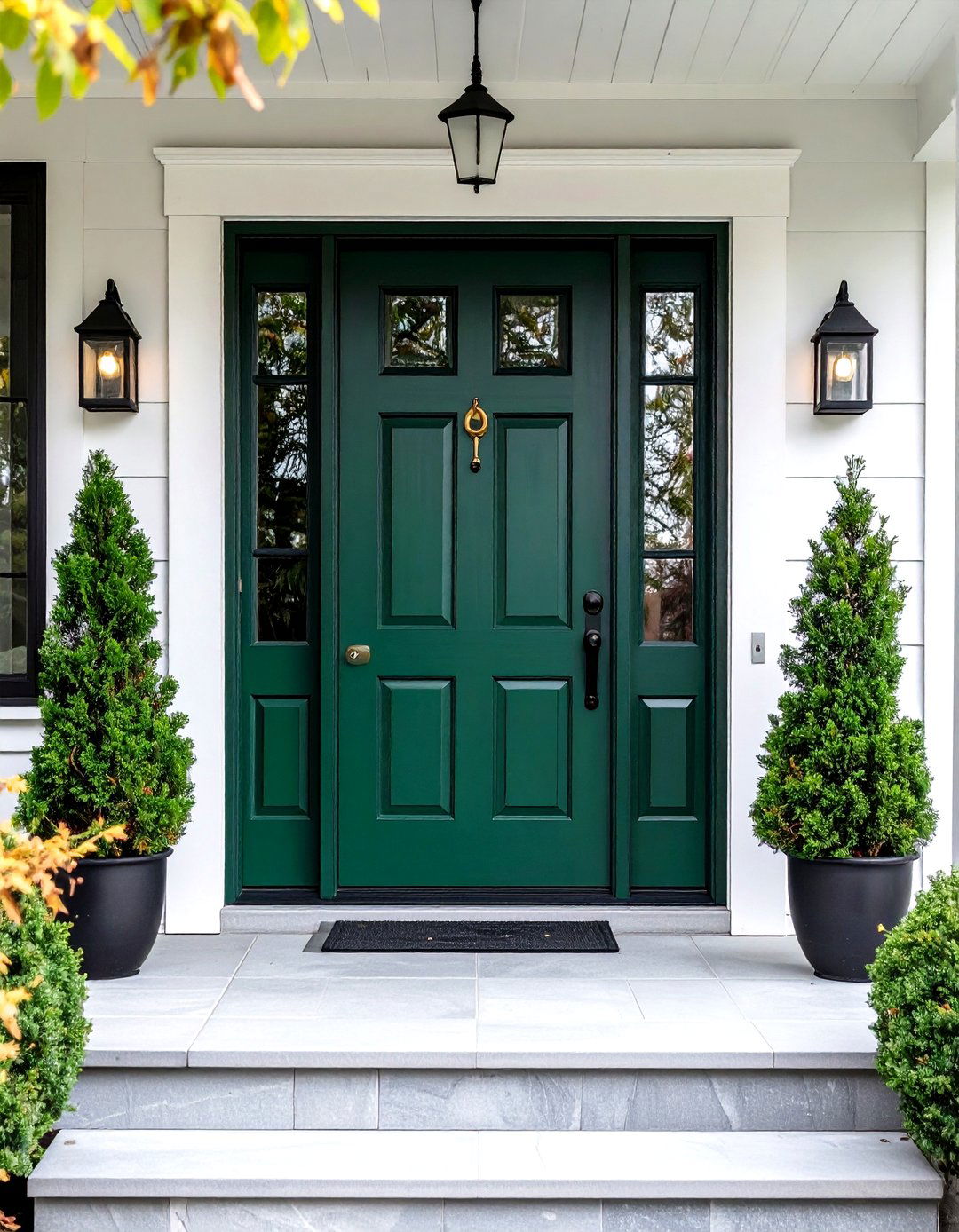
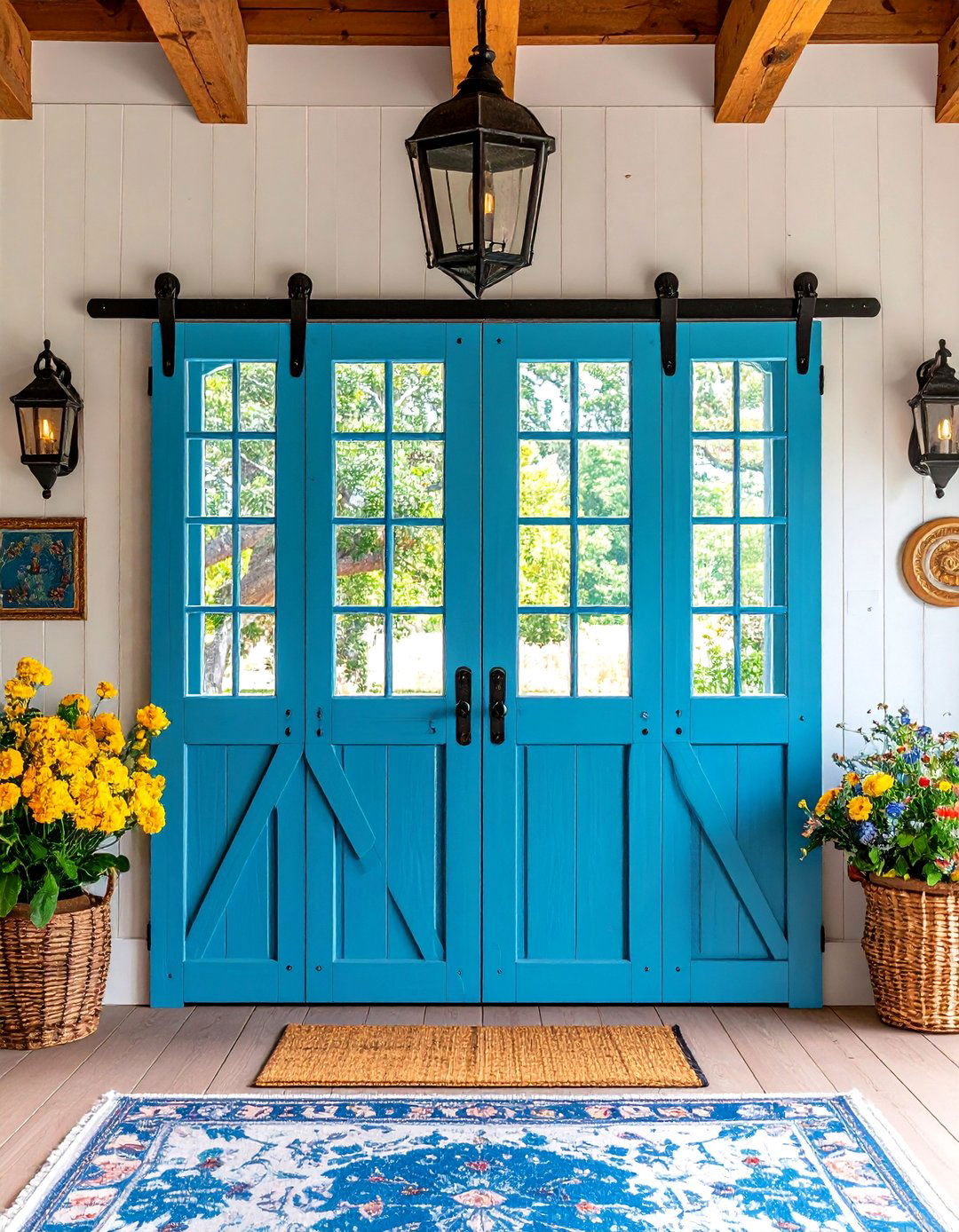

Leave a Reply